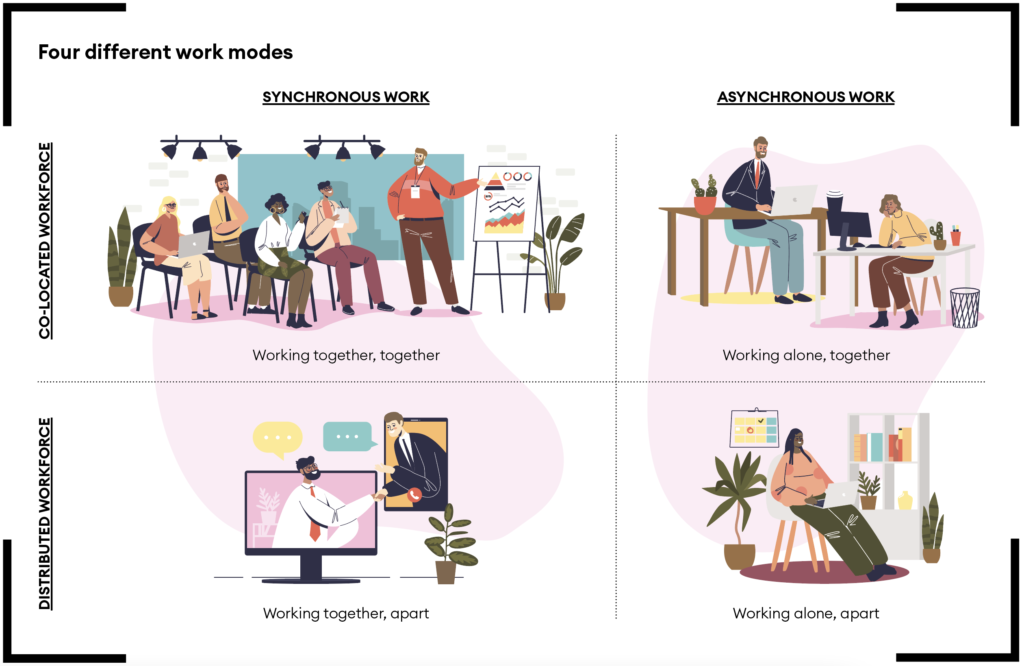We are entering a historic new era – but hybrid work needs to be designed around people, not location.
There have been few moments in the history of work that have been as definitive as the one we find ourselves in now. I liken it to the moment when electricity was harnessed, forever changing the course of the Industrial Revolution – or indeed the point at which the internet ushered in the digital era.
What we have been privy to over the last two years is, simply put, the normalization of remote work. That normalization has, in turn, invited us into a new era: the era of hybrid work.
Hybrid, in its simplest form, means that we are not bound to any one location from which we work. This may not seem like a new construct – and that’s because it isn’t. What the pandemic has enabled us to prove is that hybrid work works. Indeed, it is hard to imagine any other situation in which this remote experiment would have been allowed to take place. Without any demonstrable loss of productivity or performance, employees the world over now have the business case they need to push back on the notion that location should be the predominant factor in work design.
Why location-centric assumptions are damaging
The challenge that remains is that leaders are still heavily influenced by assumptions about work that are deeply tied to a location-centric mentality. They are assumptions like: “If I cannot see my employee working, they are not working.” Or: “Without water-cooler moments, there can be no innovation.”
It is perhaps because of these assumptions that so much of our early reaction to remote work was to simply try to recreate the office at home. Organizations have attempted to recreate water-cooler moments through technology by adding more virtual interactions. They have tried to recreate employee visibility virtually by adopting more monitoring tools. These solutions might have seemed natural, but we now have a better understanding of how damaging they have been, by driving fatigue and burn-out. The home environment – indeed the virtual environment – is a fundamentally different space to the office. Attempting to virtualize the office is leading to unhealthy work patterns. At the beginning of 2021, 40% of the remote or hybrid workforce had reported an increase in the length of their average working day since the start of the pandemic.
We cannot recreate the office outside of the office – and the aspiration shouldn’t be to try. Employees have been vocal in their desire to retain the flexibility that remote work has given them. They do not want to give up the autonomy that allows them to build work days that work for them, rather than a broad one-size-fits-all category. “There is only one person in the world who knows what works best for my personal circumstances – and that’s me,” one interviewee told me over the course of our six-month research into the dynamics of hybrid work. In fact, 68% of employees who have been fully remote during the pandemic prefer a hybrid work model. So rejecting hybrid work is not a solution. Virtualizing the office isn’t one either.
Hybrid done poorly
For hybrid work to succeed, leaders must stop placing location at the centre of how we work. Hybrid done poorly is hybrid designed around a location. Leaders must reject office-centric mentalities – among them, those beliefs that visibility and water-cooler moments are key to driving performance – and look to a new element to be placed at the centre of work design. That new element is the individual.
Ironic as it may seem, given the human capacity for unpredictability, individuals will now be the most stable pillar in a model in which there is no set place from which we work. Designing around human behaviour, particularly in an era of technology-driven workflows that significantly affect and influence human behaviour, will be the differentiator between good and bad hybrid work design.
The task is huge. It requires a fundamental understanding of human behaviour in all its complexity. It requires us to ask rather than tell, adopt root cause decision-making and open ourselves up to vulnerable conversations. It is perhaps the furthest away from the traditional corporate mindset that we’ve been – a real blurring of what we have historically deemed personal and professional. If the most valuable skillset a leader can now possess is the ability to demonstrate empathy, what does that say about where our work design is headed?
Think about time-spend
Bad hybrid work design leaves the individual out of the equation – or at least makes them only a secondary consideration. For example, mandating that employees should be in the office Mondays and Tuesdays and at home the rest of the week is a hybrid approach. But it is not a human-centric approach. It does not take into account that this mandate might not work for every individual: that some parents might want to pick up their kids from school early on Mondays, or that some employees really struggle with the Monday commute.
A human-centric approach would be, instead, to focus on the work that needs to be done and how each employee can best be positioned to deliver against it, based on their individual circumstances. To break this down into a simpler equation, Gartner advises leaders to think about hybrid work not just in terms of location, but also in terms of time-spend. In a hybrid set-up, two modes of location will be available to us: co-located and distributed. This is where many leaders stop their thinking. But just as important is to evaluate how we are spending that time: whether it is asynchronously or synchronously. Charting work against these two dimensions yields four different work modes.

Adopting a human-centric approach to hybrid work means thinking carefully about what each of these modes offers employees. This, in itself, will differ substantially from employee to employee, based on their own individual work preferences, tenure, and personality types. For instance, Gartner’s research found that extroverts thrive with in-person interactions: they need opportunities to ‘work together, together’ during their workday. Unsurprisingly, introverts really need the ‘working alone, apart’ mode – they recharge when they are away from others.
Interestingly, new hires and entry-level employees really need the ‘working alone, together’ mode. This is the place that allows them to passively observe how others are doing their work, and become acquainted with organizational culture. Observing colleagues interact in the physical space is 25% more important for junior-level talent to complete their work compared to their more senior colleagues.
What’s clear is that investing solely or primarily in just one or two of these modes will not be inclusive of all different types of needs. Leaders must invest equitably in all four modes.
Human-centric work
By viewing hybrid work not as a threat to performance, but a substantial opportunity, leaders can begin to see that hybrid really just expands the number of work options available, which in turn enables employers to offer a workplace that suits the majority of their workforce.
A progressive approach to hybrid work might be for teams to sit down and map out how their work would benefit from time in each of the four modes. Across the lifecycle of the project, when would it be important for people to work ‘together, together’? When would it be important to work ‘alone, together’?
The likely result would be that no one week would look the same as another. In a ten-week project, teams might only identify a handful of days where they would find themselves in the top half of this grid, but they would be significant moments that matter. Getting better versed in which these are is essential to employee engagement.
Our relationship with work has become a lot more intimate over the course of the pandemic. With travel bans in place and social or leisure activities significantly curtailed, for many of us work has been the only constant over the course of the pandemic – and it has been a constant constant. The burden on work to be fulfilling and purposeful – to be human-centric – is higher than ever before. If the work to be done is not fulfilling, challenging and enjoyable, employees are more likely to seek a change. Is it any wonder that 65% of employees say the pandemic has made them rethink the place work should have in their lives?
The success of hybrid work hinges on organizations’ ability to understand complex human behaviour, to design workflows and systems around it, and to offer compelling and purposeful work that will keep individuals engaged. It is by no means an easy feat, but it is perhaps a long overdue one. For most office workers engaged in knowledge work, work has never been just about the paycheque. There is a clear need now for work to meet the upper echelons of US psychologist Abraham Maslow’s ‘hierarchy of needs’. This type of work should not be about surviving, but thriving.
Leaders must develop the skillsets that allow them to approach work in a much more human-centric way, seeing workers not as resources to meet demand but as another kind of demand themselves. Workers have new and robust expectations for their employers and failing to meet them is perilous, as we are seeing in the ‘Great Resignation’.
On the other hand, success in meeting today’s expectations around work might just usher us into the next era of work – one of heightened creativity, innovation and inclusivity, and one where the human is truly placed to do their best work.




